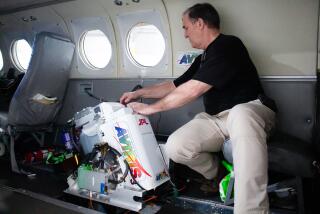Scientists Are Hoping for Dual Probe of Pluto’s Secrets : Exploration: By 1998, two lightweight spacecraft could be ready for the 2.8-billion-mile trip. But will there be federal financing available for the $400-million project?
- Share via
Cold, lonely and isolated at the edge of the solar system, Pluto is still waiting for visitors.
The veil of mystery may soon be lifted from this littlest, most distant and most inscrutable of the sun’s nine planets, the only one in the solar system that hasn’t been surveyed by spacecraft.
Two small, unmanned craft could begin the 2.8-billion-mile journey to Pluto as early as 1998. They would reach the planet seven or eight years later and beam back the first detailed pictures and information. This is the scenario envisioned by scientists at Caltech’s Jet Propulsion Laboratory in Pasadena.
Pluto’s closest approach to the sun--about 2.7 billion miles--occurred more than two years ago, and the planet is again headed toward the edge of the solar system. As it moves away from the sun, colder temperatures will condense its atmosphere.
“It’s essential we see the planet before the atmosphere is frozen onto the surface, making it inscrutable for the next two centuries,” says astronomer Richard J. Terrile, mission scientist for the Pluto flyby.
Given this urgency, the investigative spacecraft will be light and small--each weighing 350 pounds and measuring about four feet in diameter.
“We’ll send them off at the highest velocity that anything’s ever been launched,” says Robert L. Staehle, Pluto team manager at the laboratory. “This will enable us to get back the first pictures as early as 2006, while the planet still has an atmosphere and some light.”
In contrast, the Voyager 2 spacecraft that sent back images from Jupiter, Saturn, Uranus and Neptune was the size of a compact car and weighed 1,800 pounds. It traveled 12 years before beaming back its first pictures of Neptune, Pluto’s nearest neighbor, in 1989.
The two Pluto-bound spacecraft may be launched as much as a year apart. Besides serving as a backup, the second probe would allow scientists to map Pluto’s entire surface.
“We’ll be going by the planet so fast that we’ll only have an opportunity to map the side facing the sun,” Staehle says. “By sending a second spacecraft, we can view Pluto’s other face when it is rotated toward the sun and dimly illuminated.”
There’s one big caveat: The $400-million mission, although a lot less expensive than previous planetary probes, must be added to already tight federal budgets.
“Each time we’ve visited a new planet, we’ve learned a great deal about our own world, and particularly the origin of the solar system,” Terrile says.
“The one thing I can guarantee is that we’ll be surprised by Pluto. That’s happened in every single planetary encounter in the past. We did not anticipate any of the major discoveries that occurred.”
As befits a distant family member, Pluto appears eccentric. It looks more like a moon than a planet. In 1978 Pluto was found to have its own moon, Charon, a satellite half its size. Pluto’s diameter, about 2,110 miles, would cover roughly two-thirds of the United States; Charon’s diameter is slightly larger than Texas.
The two are called a “double planet.” Astronomers hope a Pluto mission will decipher the origin of this odd couple and their relationship to the rest of the solar system.
Clyde Tombaugh, who discovered Pluto in 1930, enthusiastically supports a trip to the planet. “We need some direct photos of the surface to help answer the vexing question, ‘Where did Pluto come from?,’ ” says the 87-year-old emeritus professor of astronomy at New Mexico State University.
Pluto has a thin atmosphere shrouded in part by methane gas, and both it and Charon probably consist of frozen water and methane mixed with rock. Pluto’s surface temperature averages minus 450 Fahrenheit. Even when the planet is closest to the sun, its light is faint.
Some astronomers think that Pluto may be the innermost representative of many small-planet-size objects that are so distant they simply aren’t bright enough to be seen from Earth. “There’s a very slim chance that a 10th planet exists,” Tombaugh says. “Ice seems to dominate out there considerably.”
Some of these distant bodies might be intermediate objects, between planets and comets. Made up primarily of ice, most comets circle the dark fringes of the solar system, barely within the sun’s gravitational grasp.
During its 248-year trip around the sun, Pluto moves in a highly elliptical orbit that crosses the path of Neptune, its nearest planetary neighbor, and steers Pluto as far as 4.6 billion miles from the sun.
Instruments on the two spacecraft will study the planet’s atmosphere, try to learn the composition of Pluto’s surface, see if there are volcanoes on it and look for evidence of geologic activity.
“We could find areas of volcanism on Pluto and erupting materials that would be considered gases on our planet,” Terrile says. Some scientists think that Triton, Neptune’s large moon, once might have been an icy, Plutolike planet that was captured by Neptune’s gravity.
“The terrains we found on Triton after the Voyager 2 mission were so unexpected and bizarre that we still don’t understand them,” Terrile says.






